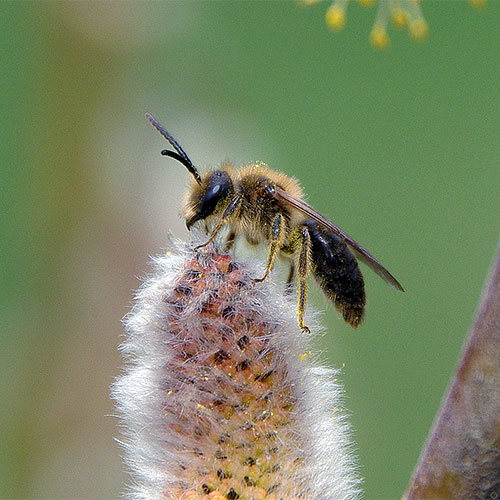Greetings, BugFans,
The BugLady photographed this lovely little bee feeding on the nectar/pollen of pussy willows in early spring. She is proceeding on the assumption that it is a Mining bee (Andrenid bee), family Andrenidae, and not one of the many look-alike small, hairy, solitary bees on the landscape.
Mining Bees
Ants, bees and wasps that live communally (in communes?) get most of the press, but there are more than 1,200 kinds of solitary bees in North America (500 are Andrenid bees) and a considerable number of solitary wasps. Mining bees are medium-sized (honey-bee-sized) bees, many of which may be seen early in the year, when there is still snow around the edges. Some are bright-colored and others are drab, and many species are identified by the flowers they visit.
Mining bees are important pollinators. The adults eat nectar (many are picky consumers of just a few plants) and they provide both nectar and pollen for their larvae. They are “buzz pollinators” that set up a vibration which causes a flower to release its pollen. Apples and other fruit trees, several species of orchids, and blueberry/huckleberry are among the plants they favor. Mining bees were “The Bee” in blueberry-growing areas until they were replaced by European honeybees, which in hindsight turns out to have been a flawed idea. Events of the past few years have demonstrated the downside of relying on a single pollinator for the majority our food crops.
Like another spring bee, the bumblebee, mining bees have densely hairy legs, head and thorax, a defense against cold. Along with the fuzzy upholstery (her hairy body also comes in handy for collecting pollen), standard equipment includes pollen baskets/combs on the hind tarsi (back legs), smoky wings, a large head with a short, pointy tongue, and chewing-lapping mouthparts that are perfect for collecting pollen and nectar.
The modus operandi of female mining bees is to excavate a vertical tunnel a few inches deep in dry/well-drained ground, either level or sloped (they like road and ditch-cuts). The entrance is the diameter of a #2 pencil or slightly larger, and there’s often a tell-tale dirt pile at the hole’s entrance. Although solitary, mining bees will tolerate the nearby tunnels of other bees that want to excavate in favorable soil, but a group of tunnels is not a colony in the true sense of the word. Each tunnel has a number of side branches that end in chambers. She waterproofs the chambers using a material she produces from a gland in her abdomen. The pollen and nectar she collects is divided among the chambers and is rolled into balls within each chamber. When Mom is satisfied that a chamber is adequately provisioned, she lays an egg on the food pile and the chamber is sealed. The larvae stay inside the chamber after hatching. They eat and pupate there, transforming into adults by fall, but not emerging from their tunnels until spring. They live for about a month after emerging.
Female mining bees are not aggressive. You have to work pretty hard to get stung by one (it can be done, if you step on or grab one), and males can’t sting at all. Sometimes when grass develops bare patches, mining bee nesting activity is blamed; in fact, the area was already bare and that’s why the mining bees picked it. The presence of mining bees hovering just above the ground in communal nesting areas or in large mating displays can be unnerving to some people (if you are one of those people, control can be achieved non-chemically simply by watering the lawn). At any rate, conspicuous displaying and foraging activity decrease after the eggs are laid.
The BugLady
